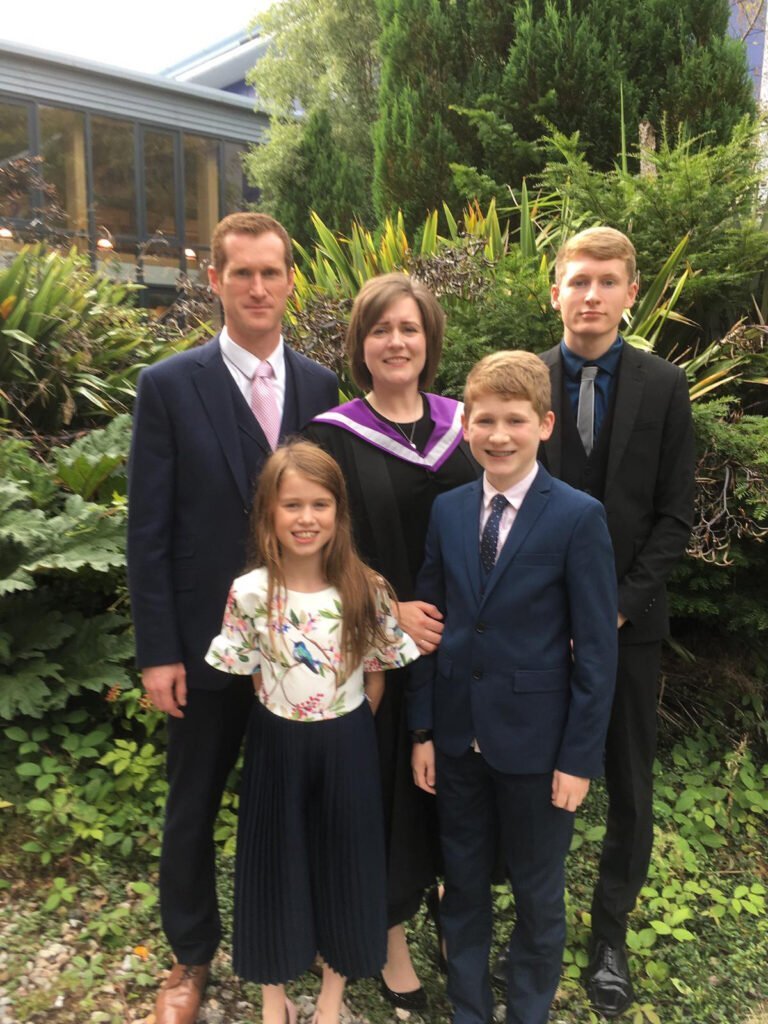
Family photo: Shona’s family is pictured with her husband, David; sons, Lennon and Anthony; and daughter, Mairi. 
Shona graduated with a Post Graduate Diploma in Education in August 2019. She is now teaching in one of the local schools – Sgoil an Iochdair.
At the launch of October’s annual Breast Cancer Awareness Month, 35 year old breast cancer survivor, Shona MacInnes from South Uist, is eager to share her story to encourage women to regularly self-check their breasts and detect cancer early.
On November 2, 2017, Shona received the devastating news she had been diagnosed with breast cancer. At the age of 33 Shona was a wife and mother of three, was physically fit and healthy, and studying to become a teacher. There was no immediate family history of breast cancer, so it was a shock to everyone when Shona received her diagnosis.
It was during her monthly breast self-examination that Shona discovered a lump in her breast and immediately contacted her local GP Practice for an appointment. After her initial GP appointment, she was then referred to Glasgow where, within seven days, she had received her breast cancer diagnosis and a treatment plan was put into action.
Shona said: “It was a tough nine months, but it shows just how important it is for women to regularly check their breasts so that if breast cancer is found, it’s more likely to be treated successfully.”
Many of the symptoms of breast cancer are invisible but some symptoms can be caught early just by looking out for certain changes in your breasts and being proactive about your breast health. Lumps can appear anywhere in your breasts, armpit or around your collarbone. Any changes in the size or shape of your breasts need to be checked out. Remember that if you do find a lump, it doesn’t necessarily mean you have cancer, but you do need to get it looked at, to rule it out. Symptoms and signs of breast cancer include:
• a change in breast size or shape • a lump or area that feels thicker than the rest of the breast
• a change in skin texture such as puckering or dimpling (like the skin of an orange) • redness or rash on the skin and/or around the nipple
• your nipple has become pulled in or looks different, for example changed its position or shape
• liquid that comes from the nipple without squeezing
• pain in your breast or your armpit that’s there all or almost all of the time
• a swelling in your armpit or around your collarbone
On July 12, 2018, Shona celebrated with her family and friends on completing her treatment and being given the news she was cancer-free. Surrounded by her husband and children, Shona enthusiastically rang the bell at the Beatson West of Scotland Cancer Centre, which signifies the end of a patient receiving cancer treatment.
She added: “I was able to get through my cancer diagnosis and treatment with the support of my family and friends, and I am so grateful to them. I am also so very grateful of the fantastic treatment I received through the Beatson West of Scotland Cancer Centre, who helped and supported me throughout my treatment plan.”
Shona urges: “Please don’t ever ignore any unusual signs or symptoms with your breasts and particularly remember to TLC (Touch, Look and Check). Remember that cancer does not discriminate, it can affect anyone – my life was going along as normal, I was busy with my daily life and family commitments while studying. It would have been so easy for me to overlook my breast self-examination, but I am so grateful that I didn’t. I found the lump, got it checked as soon as possible, and now I’m cancer-free.”
If you would like more information on breast cancer awareness and signs and symptoms visit: www.getcheckedearly.org/breast-cancer
You can also visit breast cancer care to find out more about being breast aware and you can read and listen to information on how to check your breasts: https://bit.ly/2kudOC6
Guide: How to be ‘breast aware’ – think ‘TLC’
It’s as simple as TLC…
TOUCH your breasts. Can you feel anything unusual?
LOOK for changes. Is there any change in shape or texture?
CHECK anything unusual with your doctor.
No one knows your body better than you and everyone will have their own way of touching and looking for changes – there’s no special technique and you don’t need any training.
It’s good to get into the habit of doing this regularly, maybe when you’re in the bath or shower, or while getting dressed in the morning. You might prefer to do it while standing up or lying down. Either way, the important thing is to be familiar with how your breasts look and feel normally, so you notice anything unusual – and remember to check the whole breast area, including your upper chest and armpits.
Changes to check for TOUCH. LOOK. CHECK
1. TOUCH • Can you feel a lump? Either in the breast, upper chest or armpits. • Is there a lumpy area? Or unusual thickening of the breast tissue that doesn’t go away? • Is there any unusual pain? Either in part of the breast or the armpit.
2. LOOK • Any change in size or shape? For example, one breast might become larger or lower than the other. • Any change in skin texture? Such as puckering or dimpling of the skin of the breast. • Any change in colour? For example the breast may look red or inflamed • What about the appearance or direction of the nipple? For example, one might become inverted (turned in) when it normally points out. • Any unusual discharge? One or both nipples might have a discharge. • Any rash or crusting? Of the nipple or surrounding area.
3. CHECK • Is anything unusual? If so, get it checked out by your doctor as soon as possible.
You may normally feel breast tissue changes or pain before or during your periods. This is why it’s important to check your breasts regularly so you get to know how they look and feel at different times of the month, and can notice any changes that are unusual for you.
If you find changes in your breasts that aren’t normal for you, it’s best to see your GP as soon as possible. You can take a friend with you if you like.
